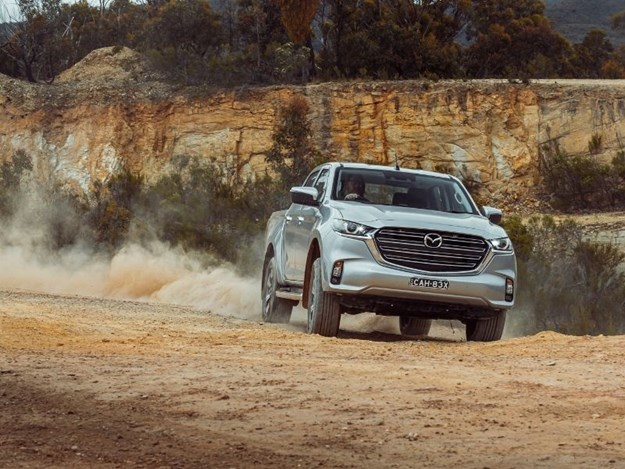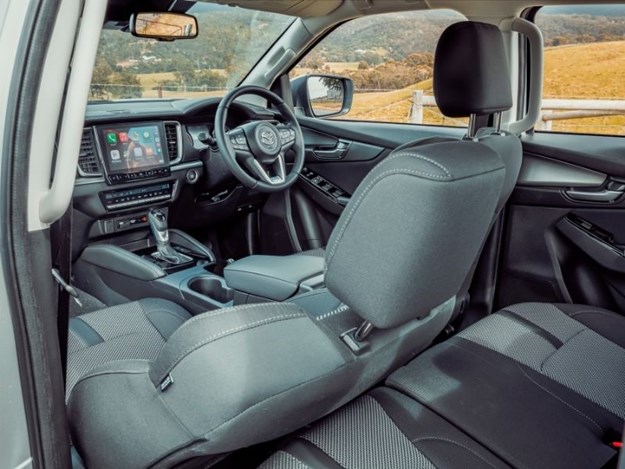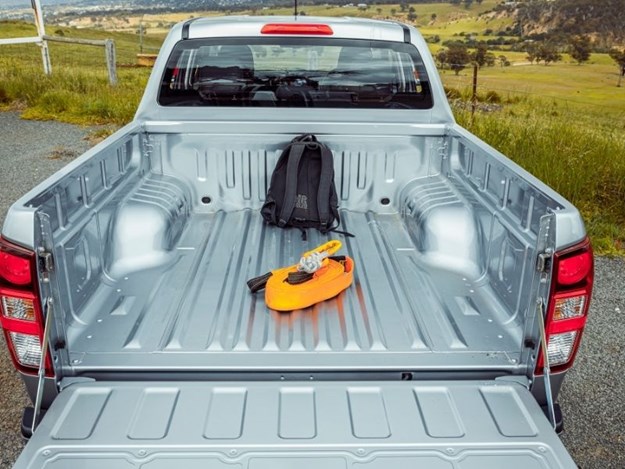The new Mazda BT-50 one-tonne ute receives the Matt Raudonikis treatment, is it a step up from its predecessors ?
 |
|
The BT-50 includes an all-new engine with a new block, internals, turbocharger and fuel system, designed to be more economical with fuel
|
Mazda has said goodbye to Ford after its decades-long partnership creating utes and other commercial vehicles, and embarked on a new era, this time teaming up with Isuzu for its new BT-50 ute.
While the earlier Ford/Mazda one-tonne utes were primarily developed and built by Mazda and then rebadged as Ford products, the last generation of the partnership was primarily developed by Ford (in Australia) with input from Mazda, then re-skinned and badged as BT-50s.
The new BT-50 is essentially a re-skinned Isuzu D-Max, and that is the all-new 2020 D-Max that launched just a few months before the BT-50 hit the market. Mazda is banking on Isuzu’s reputation for engineering strong, reliable vehicles and class-leading levels of safety technology in sharing the D-Max’s platform, while wrapping it in stylish sheet-metal to make it distinctly Mazda.
POWERTRAIN & PERFORMACE
While many drivers appreciated the old Ford-built five-cylinder 3.2-litre diesel engine for its relaxed and loping torque delivery that never seemed to raise a sweat, it did come at the expense of fuel consumption, which was always a criticism of the old BT.
Conversely, Isuzu’s 4JJ series of four-cylinder, 3.0-litre diesel engines have always been some of the more efficient on the market, and the latest iteration of the mill takes this even further. It’s pretty much an all-new engine with a new block, internals, turbocharger and fuel system designed to be more refined and economical than past generations.
In this XTR 4×4 auto trans specification, the BT-50 is rated at 8L/100km of diesel use on the Australian Design Rule combined scale. On our test it returned 11.4L/100km over a mix of urban and bush tracks, highway driving and a couple of hours of off-roading.
The engine’s power and torque figures of 140kW and 450Nm are at the lower end of the class standards and slightly down on the 147kW and 470Nm the old 3.2 made, but peak torque is available from 1,600 through to 2,600rpm, so it still maintains that bottom-end grunt you want in a working ute.
The engine is smooth and quiet at cruising, light-throttle speeds, but it has the unavoidable noise of a four-cylinder mill when you lean on the accelerator and make it work. It is refined most of the time, only showing its diesel design hallmarks when pressed hard.
The auto transmission is a six-speed unit from Aisin that proves to be intuitive when you want it to be; downshifting on descents and holding gears at large throttle openings, while remaining smooth and out-of-mind when cruising on the highway or negotiating the suburbs.
 |
|
The engine is smooth and quiet at cruising, light-throttle speeds.
|
ON-ROAD
The powertrain delivers adequate but unremarkable performance, resulting in the BT-50 being no high-performance sports ute but something that will get the job done. As mentioned, it’s relatively quiet and refined, except at wide open throttle.
We were driving the BT unladen over highways, country roads and forest tracks and, as with all one-tonne utes without a load in the tray, the ride is a bit jittery, particularly in the rear end. The XTR and top-spec GT variants ride on 18-inch (46cm) alloy wheels with 265/60 aspect tyres, while the entry-spec XT model gets 255/65 tyres on 17s. 17s are the smallest wheels possible on the chassis due to the large 320mm front brake discs – the rear brakes remain drum. The braking displayed nothing worth mentioning during this unladen drive, but with the big discs up front they should prove up to the task when towing or hauling a load.
This chassis package is an all-new design from Isuzu, so don’t go thinking the BT will be anything like an old D-Max. It’s a huge step-up in ride and handling from the old model, but maybe not so much from the old Ford T6-derived platform under the last BT-50.
Another big step-up is safety, and part of that package includes lane departure warning (LDW), lane departure prevention (LDP), emergency lane keeping (ELK) and lane keeping assist system (LAS) systems. All these systems work together using cameras mounted high in the windscreen that read the road marker lines and use the electric power steering to keep you in your lane, warn you if you are drifting from your lane and mitigate an accident when changing lanes to overtake.
These are all good systems for helping prevent accidents, but they can become intrusive on narrow country roads, narrow multi-lane highways, or in situations such as when there are two left lanes exiting from a motorway – in this instance, the system tries to prevent you turning left from the right-hand exiting lane because there is a vehicle alongside in the left-hand exiting lane. Drivers will need to make a point of experiencing these systems early on to be made aware of what is happening when the steering wheel is tugged away from your input, as it could be very unsettling if you were not expecting it.
Personally, the calibration of the systems is too sensitive and you get too much intervention with too many warning beeps when driving in general conditions. They can be switched off in the settings menu but default back on when the car is stopped and restarted.
One safety feature I love and think should be on all new vehicles is rear cross traffic alert, which warns you of approaching vehicles, pedestrians or cyclists when reversing out of a parking spot. This is particularly useful on longer vehicles like double-cab utes and it’s great to see it on all BT-50 variants.
 |
|
This time, Mazda has teamed up with Isuzu for its new BT-50
|
OFF-ROAD
The new BT-50 retains a traditional part-time four-wheel drive system with high and low range, and gets a driver-selectable rear locking differential to help out when the going gets tough.
The ride quality over pot-holed forest roads was a bit harsh, bearing in mind the ute was unladen and would soften-up with some more weight on board. The live axle leaf-sprung rear axle offers a moderate but not great level of articulation, while up front the travel of the independent front suspension is relatively poor but on par for the type of vehicle the BT is.
That leaves traction aids to get you up a climb where tyres lose grip, be that from lack of travel or the fact they are OE highway terrain low profile rubber. The electronic traction control does its thing well up to a certain point, where you then need the rear locker. Activating the locker deactivates the electronic traction control across both axles, so the front end becomes a single-spinner as it can’t distribute the drive to both wheels, or at least the one with the most grip. This required backing up and relying on the locked rear end to push the BT over the lip.
Speaking of going over the lip, the side steps are excessively big and are the first thing to scrape. They’d also be the first thing to remove on any BT heading off-road. The rear bumper also hangs particularly low, and those rear corners look particularly vulnerable.
We’re super keen to see a new BT with some metal bumpers, a bit of suspension lift and some bigger all-terrain rubber.
INSIDE
The interior of the mid-spec XTR is a stylish place to ride in, keeping with its exterior looks. Stitched leather-look covering on the dash, a big eight-inch (20cm) A/V screen and stylishly laid-out buttons for the HVAC all add to the look. Unfortunately, it’s all buttons and no dials for audio volume or HVAC temperature control, which is a pet hate of mine. Large tactile dials are easier to find without taking your eyes off the road and they’re quicker and simpler to use.
Scrolling through the settings menu to set your preferences for warning beeps, lane departure and other customisable settings is also fiddly and not something you can do on the move.
 |
|
The dash is stylish but can be fiddly, with no dials for volume adjust or HVAC control
|
The front seats are very comfortable and hug the occupants, and the steering wheel is thick and has a premium feel to it. The steering column is adjustable for both reach and height, which is a plus, but the auto-up function on the windows is only on the driver’s glass.
Rear seat accommodation is on par for the class; it will take two adults or three children without trouble. Three big blokes across that back would be a squeeze. Without having the two side by side, it’s difficult to judge if the new BT is any bigger than the old model inside, considering that when the previous model came out it boasted one of the bigger cabins in the class.
The safety systems got a bit confused when off-road as it threw up a collision alert as we approached a big puddle, but thankfully falling short of emergency braking. Most of these systems should be automatically disabled when in low range and I’m not just picking on Mazda here.
PRACTICALITIES
As expected of the class of vehicle, the BT-50 has a 3,500kg towing capacity and a 5,950kg gross combination mass. Gross vehicle mass is rated at 3,100kg, and in the 2,030kg XTR 4×4 auto ute that leaves you with a 1,070kg payload. Even the top-spec GT model has a payload higher than one-tonne at 1,065kg, which is pretty stout.
The factory tub measures 1,571 x 1,530 x 490mm (LxWxH) with 1,120mm between the wheel arches.
The engine draws its air from above the radiator support where it is sealed to the bonnet, and Mazda gives the car an 800mm wading depth with this set-up. Ground clearance is quoted as 240mm.
Mazda has a range of factory accessories for the BT-50, including a steel bullbar that maintains the car’s safety rating, plus various LED lighting and tonneau cover options. Significantly, by placing the cameras for the safety tech up high in the windscreen, it has made it easier for manufacturers to develop bullbars and other frontal accessories for the car; although, it will be interesting to see if the cameras are affected by a UHF antenna mounted on a bullbar in front of them. Expect all the major aftermarket players to have a range of kit available for the BT-50 very soon.
CONCLUSION
In some ways the new BT-50 represents a big step up from Mazda’s ute offering, while in others it is just maintaining the status quo.
The pluses include the fact this is an all-new platform representing the latest in this class, the massive raft of safety equipment that is standard across the range, big improvements in fuel economy and a more stylish appearance (in my opinion anyway).
On the other hand, power and torque numbers are considerably down on the leaders in class (and it feels it), while being marginally down on the outgoing model. The cabin is a step up in equipment levels but is no more spacious and some of the key functions are fiddly to operate.
At $57,210 (+ORC) the BT-50 XTR is comparable to an LS-U D-MAX ($56,900) and is slightly cheaper than a Ranger XLT 3.2 ($59,440 on-road) and SR5 Hilux ($59,920), making that mid-range double-cab 4×4 ute segment highly competitive.
 |
|
The factory tub measures 1,571 x 1,530 x 490mm (LxWxH) with 1,120mm between the wheel arches.
|
WHAT YOU GET
All 4×4 models in the new BT-50 range get the same engine and choice of six-speed manual or auto transmissions. They all get the full swag of safety tech, including autonomous emergency braking, adaptive cruise control (auto only) the lane keeping/departure systems, reverse cross traffic alert, pre-crash safety, traffic sign recognition with speed warnings, blind spot monitors, electronic traction and stability control, trailer sway control, daytime running lights and eight airbags.
Wireless Apple CarPlay/Android Auto is standard, giving you sat-nav and connectivity. The XT has a seven-inch (18cm) screen, while the XTR and GT get the bigger eight-inch (20cm) job.
The top models also get dual-zone climate control over the XT’s standard air-conditioning, and eight speaker audio over the XT’s six speakers. Other features exclusive to the GT include leather seats with heating on the front pair and power adjustment on the driver’s seat, plus chrome door mirrors.
SPECS
Engine: I4 3L diesel
Max power: 140kW @ 4,000rpm
Max Torque: 450Nm from 1,600–2,600rpm
Transmission: Six-speed automatic
Transfer case: Part time 4×4 w high/low range
Crawl ratio: 33.3:1
Steering: Electro-hydraulic
Front suspension: IFS w/ upper and lower control arms, coil springs, stabiliser bar
Rear suspension: live axle under leaf springs, stabiliser bar
Tyres: 265/60-R18
Kerb weight: 2,030kg
Payload: 1,070kg
Towing capacity: 3,500kg
GVM: 3,100kg
GCM: 5,959kg
ADR combined Fuel Use: 8L/100km
Fuel use on test: 11.4L/100km
Fuel tank: 76L
Approach/ramp-over/departure angles: 30.4°; 23.8°; 24.2°
Ground Clearance: 240mm
Wading depth: 800mm
Photography: Alistair Brook

